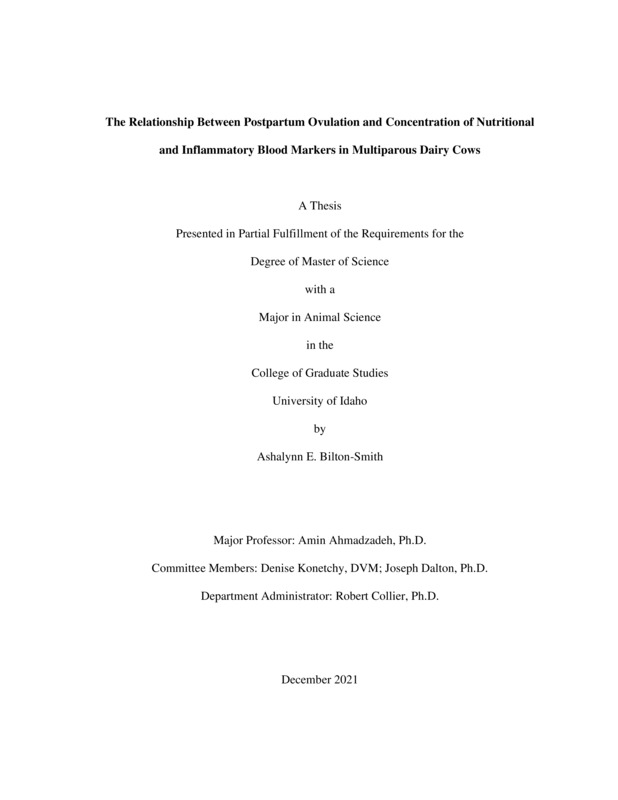The Relationship Between Postpartum Ovulation and Concentration of Nutritional and Inflammatory Blood Markers in Multiparous Dairy Cows
Bilton-Smith, Ashalynn. (2021-12). The Relationship Between Postpartum Ovulation and Concentration of Nutritional and Inflammatory Blood Markers in Multiparous Dairy Cows. Theses and Dissertations Collection, University of Idaho Library Digital Collections. https://www.lib.uidaho.edu/digital/etd/items/biltonsmith_idaho_0089n_12188.html
- Title:
- The Relationship Between Postpartum Ovulation and Concentration of Nutritional and Inflammatory Blood Markers in Multiparous Dairy Cows
- Author:
- Bilton-Smith, Ashalynn
- Date:
- 2021-12
- Program:
- Animal and Veterinary Science
- Subject Category:
- Animal sciences
- Abstract:
-
Previous research has shown the association between negative energy balance, changes in blood metabolites, and reproductive performance. Cows that ovulate later in the early postpartum period exhibit an increased time to pregnancy. Thus, delayed ovarian cyclicity ultimately leads to longer calving intervals, multiple AI attempts, and loss of profit. Although relationships exist between inflammatory blood biomarkers and disease states, the relationships between these biomarkers, postpartum ovarian cyclicity, and fertility in dairy cows have not been thoroughly investigated. The objective of this study was to examine the relationship between body condition score (BCS), glucose (GLU), cholesterol (CHO), free cholesterol (FCHO), serum amyloid A (SAA), and resumption of ovarian activity during the early postpartum period in lactating dairy cows. Sixty-seven multiparous Holstein cows were monitored from 2 weeks prepartum to 8 weeks postpartum. Weekly blood samples, BCS, and ultrasonography were obtained to characterize inflammatory responses, energy status, ovarian structures, blood progesterone (P4), and the approximate timing of ovulation. Cows were divided into two groups; early ovulation (EO < DIM; n=21), vs late ovulation (LO >28 DIM; n=46) and healthy (H; n=40), vs sick (S; n=27). As expected, BCS decreased over time for both groups (P < 0.01). However, BCS was greater for EO (2.8 ± 0.09 score) than LO (2.5 ± 0.06 score) (P < 0.02). Mean blood CHO concentrations were greater in EO when compared with LO in weeks 4,5 and 8 (P < 0.03). The rate of increase in CHO over 8 weeks tended to be greater for the EO group (P < 0.08). There was no difference between EO and LO groups regarding blood SAA, FCHO, or GLU concentrations. When comparing H and S groups, mean CHO concentrations were greater in H than S in weeks 4,7, and 8 (P < 0.01). The overall pattern of blood CHO concentrations during the postpartum period increased over time and tended to be greater in H cows when compared to S (P < 0.06). The mean SAA concentrations in S cows were greater than H cows (138 ± 13.4 vs 76.1 ± 11.1 ug/mL) (P < 0.01). There was no difference between H and S groups regarding BCS, FCHO, or GLU concentrations. These results provide evidence that BCS and blood CHO concentrations during the early postpartum period are associated with the timing of the first postpartum ovulation in multiparous cows. Blood CHO and SAA concentrations are also associated with the presence of a disease state in early postpartum cows. Therefore, these markers may be used as a tool to identify late ovulating cows, or cows experiencing disease, and provide an opportunity for producers to better manage these cows.
- Description:
- masters, M.S., Animal and Veterinary Science -- University of Idaho - College of Graduate Studies, 2021-12
- Major Professor:
- Ahmadzadeh, Amin
- Defense Date:
- 2021-12
- Identifier:
- BiltonSmith_idaho_0089N_12188
- Type:
- Text
- Format Original:
- Format:
- application/pdf
- Rights:
- In Copyright - Educational Use Permitted. For more information, please contact University of Idaho Library Special Collections and Archives Department at libspec@uidaho.edu.
- Standardized Rights:
- http://rightsstatements.org/vocab/InC-EDU/1.0/

